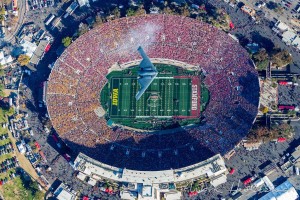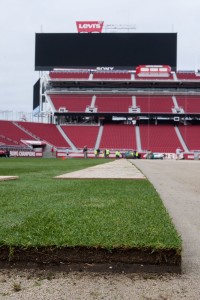Jan
El Nino, Drought, and Your Lawn
We have been hearing about El Nino for some time now and it’s finally upon us. To most of us it spells relief that the drought may finally come to an end. We have been battling one of the worst droughts in history the last few years, and snow and rain will allow many to breathe a sigh of relief. By no means are we out of the woods yet as a few days of snow and rain won’t take care of the problem. It appears the weather models will be correct for this spring. It’s going to be wet spring which will bring back a lot of landscape areas that were put into seasonal dormancy to save water.
As I drove into work this morning I saw two common areas that had their sprinklers running while it was raining. It has been raining for the last four days and it doesn’t appear to be letting up until the weekend. While none of us want to interfere, it is important to let your homeowners association or city know that water is still running in these areas. There is only so much water we can save at our residences, but there are others areas we can step in. Most parks have the irrigation clocks set to run daily, and there is not enough man power to check the areas daily or even weekly. One way to fix this problem is the addition of rain sensors or gauges that attach to the irrigation clock to shut off the sprinklers. I know we can’t go back and fix all the parks that were put in past years, but we can make sure that all new areas are doing everything they can to save water. The majority of people are extremely responsible users of water and we need to encourage others to also use water wisely.
One thing that has been lost in the drought is how important landscape and natural turfgrass areas are to our cities. They don’t just beautify areas–they reduce noise and air pollution, serve as a natural aquifer, cool the surrounding areas, and are natural fire breaks against wildfires. I feel it’s vital that we learn from the drought. It’s important to realize that we don’t need to use as much water as previously thought, and you can still have a lush, beautiful landscape. Turning off our irrigation systems all together is not going to solve the water problem, it’s going to create new environmental challenges. The key here is to be smart with our water. Use plants and trees that are native to the desert areas or can thrive in warm temperatures. Warm season turfgrasses like bermudagrass and paspalum survive long periods of time without water for a reason. They’re adapted to the natural environment so remember that when the rain stops and you set your clock to run every day. They only need water every other to every third day to stay green. They can go weeks without water and still survive. Water smart.
Fertilizers
Let’s talk about fertilizing our winter lawns. Over the holidays we saw temperatures dip down into the 20’s in several areas which caused a lot of lawns to lose their color. When the temperatures drop that low we see one of two things happen. The first is that any semblance of warm season grass that was holding on to its color went completely dormant. When this happens you typically see little brown spots throughout the lawn. While it may be unsightly for a few weeks there is no cause for concern. Look on the bright side, these areas will have no competition in the spring with the ryegrass which will make for a smooth transition. The second thing that happens is the nutrients in the lawn have been used utilized by the plant and now the lawn has lost its color and is pretty yellow. This is the most common thing we see at this time of the year.
Granular fertilizers are slow to break down during the cold winter months and the plant can’t uptake the nutrients. So what can you do? The best thing to do is to apply foliar fertilizers. This isn’t always the easiest and most convenient option, but it is the best during the winter. There are several fertilizers that can be tank mixed and sprayed on to your lawn to provide the necessary nutrients. One of my favorite spray mixes is the combination of Ferrous sulfate (iron) and potassium nitrate. This will provide plant strength, color, and enough juice to get your lawn through this cold period. You can also buy pre-mixed foliar fertilizers that contain a high percentage of iron to get some of the color back. Remember that both will stain your sidewalks, patios, etc. so keep them away from anything you don’t want to rust. You can return to granular fertilizers in mid-February as the temperatures begin to warm up.
This doesn’t apply to starter fertilizers. I still recommend putting down Soil Burst 4-4-2 on the ground prior to a new sod install. A good starter fertilizer will work its way into the soil and can be taken up by the new plant roots.
Pre-emergent herbicide
Every year I talk about the importance of timing when it comes to a pre-emergent herbicide. You need to get it into the ground prior to the weed development to create a barricade at the soil level. In Arizona and California the best time to apply one is between the 1st and the 15th of February.
Here is a small list of some of the more popular pre-emergent herbicides on the market for bermudagrass and paspalum, and they can be picked up at most specialty stores and used safely. Some of these do require a certified applicator to apply so you may want to contact a weed company to apply them for you. You will not be able to purchase the restricted use pesticides without a license. Many stores will carry their own generic brand of these chemicals but make sure you are getting the same active ingredient. If you cannot find one of these products in the store most of them are available online to ship to your door. Herbicides are generally not cheap but they are effective when used right so make sure you do some research.
Barricade 65WG (Prodiamine) • Dimension (dithiopyr) • Ronstar (oxadiazon) • Pendulum (pendimethalin)
Before making an application of a pre-emergent herbicide it is important to follow the proper steps and always read the label.
After you apply the herbicide, irrigate your lawn to activate the chemical. • Measure your lawn surface area and calibrate your spreader properly. • Do not over apply an herbicide hoping for better results. • Some products allow for a second application. Read the label first! • Newly installed lawns (within 90 days) should not use a pre-emergent.
Post-emergent Herbicides
Post-emergent herbicides can be used if you get in a pinch if a few weeds emerge from the turf, or if you prefer to treat on an as needed basis. These chemicals will work to control weeds, but you need to be careful when applying them. Never exceed the rates on the label and follow extreme care when using them. Too much herbicide can cause root damage to your lawn.
Speedzone
Trimec and Trimec Southern
Battleship III (not labeled in CA)
Revolver (Poa annua removal. This product will also kill ryegrass so only use on dormant turf or during bermudagrass/paspalum growing season)
If you have any additional questions please let me know. Just click on the “Ask Jay” button on the top right of this page. Remember to get outside and flip your irrigation clock off until you start to see your lawn show signs of stress.
Until next time,
Jay
PS……we have had a few exciting projects lately! We are proud to have grassed the Rose Bowl
and just finished grassing Levi’s Stadium for Super Bowl 50!
Be sure to “Like” us on Facebook to keep up with all of our latest projects!



